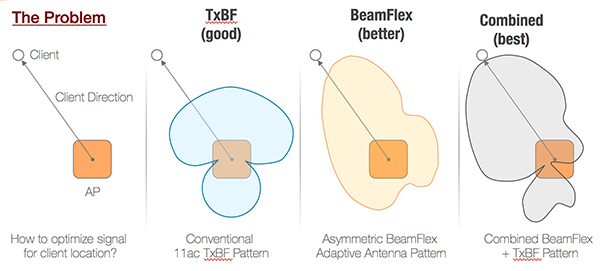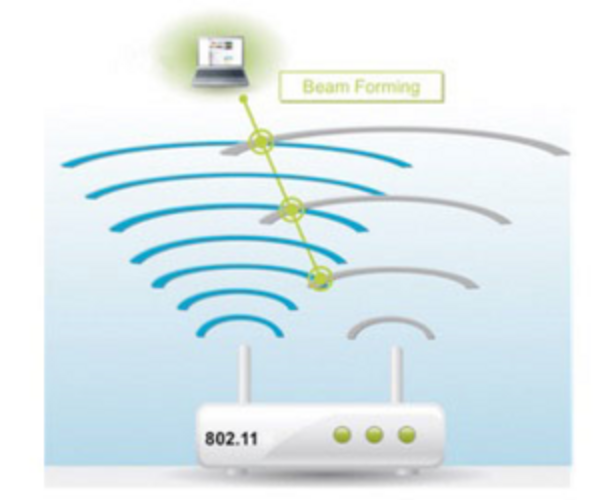
Getting a Good Grip on Chip-Based Transmit Beamforming
Transmit beamforming, or TxBF, remains an optional feature in 802.11ac but is essential for making MU-MIMO work. So vendors must deploy it in their Wave 2 products. Here’s how it works. Basically, TxBF allows an AP to concentrate RF energy in the direction of a particular client by using signal processing techniques at the baseband chip level. TxBF requires feedback from the client to allow the AP to synchronize the transmissions from multiple chains so they end up in phase when they are received. This results in some link budget gain. Depending on the number of transmit chains available, TxBF can provide signal gain up to 3 or 4dB in ideal conditions. However with adaptive or smart antenna technology, a compliment to TxBF, there is no such limits and the gains are cumulative. 
Another Primer on MIMO
MIMO, for multiple input multiple output, was first introduced in 802.11n. It added multiple transmit and receive antennas on both sides of the radio link. The chipset sends information in two or more spatial streams, each one transmitting via a separate antenna. The corresponding antennas on the receiving radio collect all the signals arriving from different paths and at different times, and the RF chipset recombines them, essentially increasing the signal-capturing power of the receiver. The multiple spatial streams pack in more data and the physically separate antennas create what’s called spatial diversity that creates slight changes in timing and other characteristics that differentiate each signal and make it easier to extract the information. The easier it is for a client to reduce the correlation between signals, the more data that can be extracted, and the more data that can be pumped into the sending side of the link. This is a hugely important aspect of getting MIMO to work the way it was designed. But until now, Wi-Fi access points could talk to only one client at a time, one after another, by means of a time-slicing to grant fair access to all the clients connected to that access point. An AP with four transmit and four receive antennas and four spatial streams (4x4:4) now has four multiple discrete spatial streams to transmit to different clients simultaneously.
MU-MIMO and RF efficiency
MU-MIMO stands for multi-user MIMO, a brand new, required feature in Wave 2. It too is implemented in hardware, in the 11ac radio chipset, and both the access point and client are required to support it. The concept is breathtakingly simple: with MU-MIMO, that same 4x4:4 access point can talk at the same time to three or four MU-MIMO clients. For example, with Wave 2 WLAN capacity is effectively doubled with single stream clients. With MU-MIMO a given access point can now handle a much larger number of concurrent clients because it’s serving clients in parallel, in batches of three, for example, and because of the higher 11ac data rates that allow clients to get off the air much faster, leaving more airtime available for other clients. Even without MU-MIMO clients, a Wave 2 WLAN can realize benefits. Just replacing a heavily burdened 11n AP with a Wave 2 11ac AP will boost the network’s capacity, serving more clients while increasing throughput even for 11n clients (as is the case with Wave 1 access points). As Wave 2 clients hit the market, MU-MIMO will kick in automatically under the covers. Transmit beamforming is applied to each spatial stream from access point to client in a MU-MIMO configuration, simultaneously optimizing the signal to the target client and minimizing the noise level with regard to other neighboring clients. The several antennas in MIMO are physically separate and the signal from each travels along different paths, but the spatial streams “mix” in the air on their way to the receiving antennas. This is why separating these spatial streams on the receiving side, often called decorrelation, is critically important. Any antenna system that can focus or direct these signals to each client or client group to ensure they appear, or are heard, differently by each client is the key to maximizing MU-MIMO performance. Apart from the physical differences of the antenna locations and the optimizations created by chip-level beamforming, is there another way to increase this differentiation, and thereby increase or sustain MU-MIMO throughput? There is. Hello smart antennas.
Value-Added MU-MIMO with Smarter Antennas
Ruckus adaptive directional antenna technology, marketed under the name “BeamFlex,” despite sounding somewhat similar to “beamforming,” is quite different. Adaptive antennas continually shape the “physical” antenna patterns by changing the antenna structure electronically. With adaptive antennas there are three important gains derived. One is simple antenna gain achieved by focusing more energy in the direction of a given client. Another is the gain from interference mitigation as smart antennas are not forced to constantly send and received signals in all directions at all times. But perhaps most important to MU-MIMO is the ability for adaptive antennas to control multipath transmission. Smart antenna systems can effectively steer one spatial stream in one direction and a separate spatial stream in a completely different direction so decorrelation and spatial multiplexing are maximized. This is critical to ensuring proper MU-MIMO operation and maximizing MU-MIMO performance. While beamforming relies on manipulating the signal timing, to alter the signal’s phase. BeamFlex is all about manipulating the antenna pattern that transmits the beamformed signal. A sophisticated (and patented) best-path selection algorithm within each access points lets the AP automatically try different combinations of antenna elements to create focused signals that yield the highest possible data rates, with thousands of possibilities. In effect, Beamflex creates a custom, optimized antenna tuned for a specific spatial stream intended for a given client device or group of clients. The uniqueness of each antenna pattern means “more signal” can be sent to the target client, and “less signal” to neighboring clients. Depending on the specific situation, BeamFlex can create up to 6dB improvement in the signal-to-noise ratio, and up to 15dB of improvement through reduced interference. The combination means higher data rates, longer range, and higher sustained data rates over those distances. With multi-user MIMO networks, BeamFlex can create these custom RF patterns for each antenna and each simultaneous MU-MIMO client group so Wi-Fi signals can be better distinguished by clients. This simply makes MU-MIMO work better. That’s pretty smart Wi-Fi.















